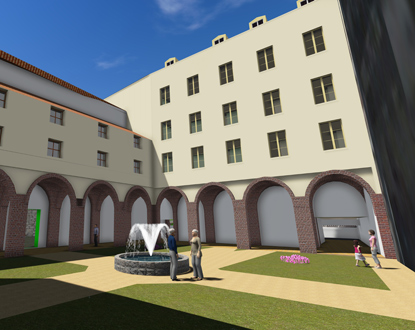During a conference, Christian Estrosi presented the masterplan for the renovation of Place Saint-François and the historical buildings that are part of it. We are aware of the fierce controversies that the CGT and the left-wing parties supporting it have ignited following the Mayor’s decision to revisit the agreement with this same union regarding its reinstatement in these premises. An authoritarian move led to the occupation by union activists and the current deadlock.
The Mayor of Nice is attempting a diplomatic maneuver through his statements to circumvent the issue. Will he succeed? Sometimes manners count more than actions…
Christian Estrosi’s remarks: “I want to be clear; I am a republican political leader. In this regard, I believe that union freedoms are an integral part of our society’s functioning. Hence, the departmental CGT was housed in renovated premises at the city’s expense, a few steps away from Place Saint-François; thus, there is still, in Nice, a CGT Labor Exchange, provided with substantial means and high-quality, spacious premises (550 m²), entirely renovated, located on one of our city’s main arteries (Jean-Jaurès Boulevard), and as long as I am Mayor, there will be a Labor Exchange in Nice.
I have always maintained, within everyone’s freedom, the most solid relationships possible with the CGT. It is rightly that the local CGT evokes the 120-year history of the Labor Exchange on Place Saint-François and the union’s commitment to the Liberation of France. And this is why I committed to ensuring that the future Maison de la Mémoire reserves a quality space for the history of the Nice working world and the institutions that represent and defend it locally.
But faced with the alternative presented to me, against the coup by certain CGT activists, and following the archaeological findings made in 2010 on the Aigle d’Or structure, I will not back down on the future of this building. However, I do not believe the CGT is responsible for enhancing heritage and preserving Nice’s medieval architecture. Each to their own trade.
Therefore, I will present a resolution at the next municipal council, which, based on the general interest of the renovation project of the entire medieval Franciscan heritage set: seek historical monument status from the State services and declare the building’s rehabilitation. I will also request the termination of the agreement that anticipated the CGT’s return to the Aigle d’Or, an agreement concluded in 2009, before the archaeological discoveries of the convent’s remains, which took place in 2010. Finally, I commit to perpetuating the existence and means of a CGT Labor Exchange in other locations.”
To conclude: “In doing so, I believe I have found a fair balance between enhancing a unique heritage complex in Nice, which has survived the ravages of time despite the mistreatment that all our predecessors, municipalities, owners, occupants have inflicted on it and to which we can unexpectedly restore all its quality, Nice’s workers’ memory and the current interests of the Alpes-Maritimes’ employees.”
Will this long statement, both firm on principle but offering a compromise in its application, be heard by his opponents?
The Communist Party has already organized a press conference today.
It’s not just the summer that will be hot in Nice!
The rediscovery of this heritage
The church and convent of the “église et le couvent des Franciscains” (Capitole + Nettoiement + Bona building + Aigle d’Or) thus represent the only testimony of Nice’s grand medieval architecture.
As for the Palais communal, it is the only public baroque palace that has come down to us, relatively intact.
Their existence has always been known, but this knowledge was reserved for a small circle of scholars. The public sections were reutilized, such as the Palais communal, granted to the labor movement in 1892. The private parts were used according to their owners’ wishes (warehouse, icehouse, hotel, cinema), and often poorly treated (as when in 1976, the city transformed the church’s ground floor into a Nettoiement depot) until they were reintegrated into the communal heritage, one after another.
Today, we have achieved complete control over the entire ensemble’s land. An initial archaeological study of the structure was conducted on the Palais communal;
A second study on the Aigle d’Or took place in 2010; a third is planned for the square itself. Each of these studies demands to be deepened. Each of these studies has confirmed what was only known through documents: the original buildings are all there, intact, submerged in later modifications, and waiting for only one thing: to regain their initial splendor.
What could this future enhancement be?
A study will be entrusted to specialists to indicate how this very complex site can be designed to preserve all its history and adapt it to its new functions:
A Maison de la Mémoire Niçoise, which will be the appropriate place to evoking the city’s entire history with today’s technologies, at least the part that, from the Ligurians to the 19th century, is absent from the museum Masséna’s museography. And why not a Carnival museum that the city sorely lacks, or even a Nice cuisine academy that would find its place beside this museum…
In addition to the overall renovation of the complex composed of the Palais communal, the church, and the convent of the Franciscans, Place Saint-François will also be renovated. The fish market and its fountain, which form the soul of the place, will be preserved, modernized, and sanitized; the Nettoiement warehouse will be relocated; parking and traffic flow will be regulated, and the terraces of establishments preserved and improved.


